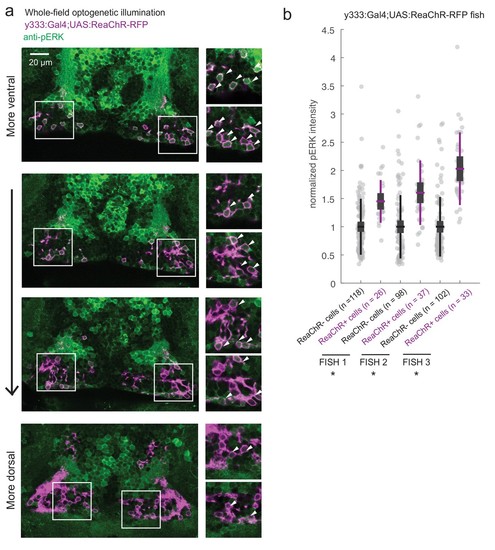Fig. 6-S1
- ID
- ZDB-FIG-200325-177
- Publication
- Wee et al., 2019 - A bidirectional network for appetite control in larval zebrafish
- Other Figures
- All Figure Page
- Back to All Figure Page
|
ReaChR activation by whole-field optogenetic illumination.( a) Tg(y333:Gal4;UAS:ReaChR-RFP) (magenta) optogenetic stimulation during feeding is sufficient to induce pERK activity (green) in many transgene-positive neurons. Fish were food-deprived for 2 hr and then fed in the presence of whole-field 630 nm LED illumination (as in Figure 6). White arrows indicate examples of cells with higher pERK activity. Scale bar = 20 ?m. Insets (white boxes) are shown at higher magnification on the right. Width of insets = 40 ?m. ( b) The pERK intensities of ReaChR-positive and -negative cells (normalized to the mean pERK intensity of ReaChR-negative cells for each fish) are plotted for three individual fish. To sample ReaChR-negative cells, all visible cells lacking red channel expression were selected in every 3rd to 5th z-plane (to minimize oversampling). Fish one corresponds to the fish in ( a). Box plot indicates mean value (horizontal line), 1 SD (gray box) and 95% confidence intervals (vertical line). Individual cells are plotted as circles. In Tg(y333:Gal4;UAS:ReaChR-RFP) transgene-positive fish, ReaChR positive cells have significantly higher pERK fluorescence intensity, demonstrating the effectiveness of optogenetic activation (p = 2.7×10?6/2.7 × 10?8/6.5 × 10?13 for each fish respectively, one-tailed Wilcoxon rank-sum test). |

